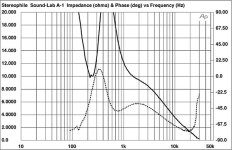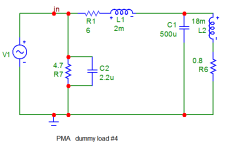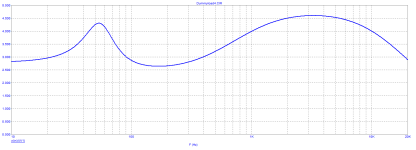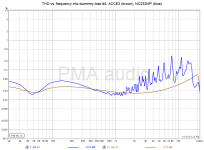The problem of reliability is that one single pair of Sankens driven to the edge of destruction can give an ever so slightly better performance in terms of THD/IMD, crossover artifacts, clipping recovery, etc. compared with two or three of the same in parallel. If all else is the same in the design (and run below the beta knee). Undersized driver/VAS can be “better” because of lower nonlinear capacitances. Sure you can get back much of the “lost“ performance due to having parts in there that can take the beating but it will be more costly and more work to get equivalent stability margins. Enhancements to the topology (ie, cascoding), taking the trouble to match components. You have to work for it, and spend the money, to get a good balance. Especially when chasing ppm.
Personally I don’t chase ppm distortion for my own use. When the residuals get low enough that it’s limited more by implementation and layout than circuit topology, I stop with any further enhancement. That turns out to be somewhere around .03%. Everything I build (even if not intended for it) is designed to be run at war volume without issues. I’ve found that what you need to do to make things work well at war volume (thermal and SOA margins, overload recovery, perceived sound quality under severe overload) tend to produce a “hi-fi-enough” result result that no improvement is necessary for my own use. Most other users have a different set of priorities - even commercial operators who want the same thing being under 10kg, and are willing to spend 10k dollars to get it. Class D design on that scale is outside my wheelhouse and outside my budget.
Personally I don’t chase ppm distortion for my own use. When the residuals get low enough that it’s limited more by implementation and layout than circuit topology, I stop with any further enhancement. That turns out to be somewhere around .03%. Everything I build (even if not intended for it) is designed to be run at war volume without issues. I’ve found that what you need to do to make things work well at war volume (thermal and SOA margins, overload recovery, perceived sound quality under severe overload) tend to produce a “hi-fi-enough” result result that no improvement is necessary for my own use. Most other users have a different set of priorities - even commercial operators who want the same thing being under 10kg, and are willing to spend 10k dollars to get it. Class D design on that scale is outside my wheelhouse and outside my budget.
Yes, but problematic.Beautifully stated.
A quote from elsewhere:
"All empirical research is opportunistic – at least to some degree. We tend to focus on topics for which data and methods are readily available. There is a widely employed metaphor used to describe research that focuses on accessible topics to the exclusion of other important avenues of research, suggesting that you are searching for your car keys under the streetlight."
https://www.sciencedirect.com/science/article/pii/S0306919220301585
There may be a beautiful way of describing being stuck in a rut, but its still being stuck in a rut.
To make this test bench universal, for any test run at a given level rather than vs power. I would like to see testing done at 2.83V and rated power, as well as a list of (optional) intermediate power levels such as 5W, 10W, 25W, 50W, 100W. The idea is to make apples to apples comparisons easier at levels other than 1W. And in the spirit of science, a standard format or recommendation for raw data release alongside the graphs.
Did you figure out what was causing that problem?...some amplifiers after play music in around one hour, then the stereo image going to bad.
Theory vs ground truth. Don on a pair of good headphones
https://www.diyaudio.com/community/threads/whats-good-enough.396039/post-7274221
https://www.diyaudio.com/community/threads/whats-good-enough.396039/post-7274221
If you're trying to characterize the potential creation of AAPA / AFOM ... etc. as moving from one rut to another, or staying within a rut; I'd disagree.Yes, but problematic.
A quote from elsewhere:
"All empirical research is opportunistic – at least to some degree. We tend to focus on topics for which data and methods are readily available. There is a widely employed metaphor used to describe research that focuses on accessible topics to the exclusion of other important avenues of research, suggesting that you are searching for your car keys under the streetlight."
https://www.sciencedirect.com/science/article/pii/S0306919220301585
There may be a beautiful way of describing being stuck in a rut, but its still being stuck in a rut.
I think I understand your meaning... and I glanced at the linked article.
To me, I think this potential testing suite (and even potentially the associated subjective scoring) could advance the understanding of a wider audience regarding how amplifiers perform under various conditions. I also stipulate that people might learn about (possible) tradeoffs between key design choices. Sure, to the most-skilled in the room it may not be anything all that new or exciting. However, having a standardized suite of testing more accessible to more people (like me) would likely further understanding. That data (if released / provided) could also be used to (potentially) bump up against some objective preference / differentiation data at a later time. It's out of scope for these metrics.
Now, if you ONLY think that getting out of the "rut" involves the holy grail of understanding how we can reliably and cheaply discern some segment of the populations' preferences without using people in the study... then I understand your thought, but I disagree with it.
The holy grail of measurements reliably predicting human preference seems a long way off. Perhaps with a monster budget and dedicated people... it can happen. I nominate you to lead the charge. In the interim, I am enjoying seeing how this progresses. I'm not going to participate as a "we", because I feel like (wisely) bonsai and team have set their final scope and guardrails. However, I'm still very excited.
In a nutshell and following your analogy - I'll take a shallower ditch along with learning a thing or two about amplifier measurements and how they apply vs. staying in the same rut. It's progress.
Thank you Boden 👍Kudo's for Bonsai and PMA to keep their relative patience with all the usual nay-sayers, who have not contributed anything to the original idea of Bonsai here. As I said before, it is about time the nay-sayers come up with a concrete amplifier design.
Mind tricks
The mind is a very advanced instrument. What makes it special is its masking capability, stimulus encountered for the first time is accentuated and later masked.
External or internal stimulus can also affect the minds interpretation and processing
Some stimulus such as pineapples, chocolate, intense or repeated stimulus can mask other stimulus.
Put on your headphones and have fun
The mind is a very advanced instrument. What makes it special is its masking capability, stimulus encountered for the first time is accentuated and later masked.
External or internal stimulus can also affect the minds interpretation and processing
Some stimulus such as pineapples, chocolate, intense or repeated stimulus can mask other stimulus.
Put on your headphones and have fun
Reliability and MTBF aren't in the assessment. You can calculate it, that is beyond the scope of the proposal.Reliability/MTBF is difficult to measure till you're already entered the market, and it can change over time due to production changes.
Also low distortion does not have to come at the expense of other performance metrics, it just takes sensible design, ~10ppm isn't hard to attain for instance with straightforward architecture into 8 ohms for class B. Same for low noise, this isn't rocket science.
One problem throughout this thread is that the word "quality" is almost meaningless, or rather has many different meanings from ergonomics to MTBF to audio performance to power efficiency to flexiblity of configuration to value-for-money to "looks stylish", etc...
Low distortion without any consideration of other factors is where the problem lies. The idea behind this initiative is that this is corrected and other, as important, aspects are addressed as part of the design process, or in the assessment of a finished or commercial amplifier.
Fair comment on the use of the word 'quality'. It must be 'technical design quality' or perhaps the word not used at all within the framework of the proposed assessment.
I do not want to muddy the waters with perceived sound quality. We all have our preferences and those have to be respected. The assessment is purely on specific technical aspects. (Sugden would probably score quite well in the tests).Mind tricks
The mind is a very advanced instrument. What makes it special is its masking capability, stimulus encountered for the first time is accentuated and later masked.
External or internal stimulus can also affect the minds interpretation and processing
Some stimulus such as pineapples, chocolate, intense or repeated stimulus can mask other stimulus.
Put on your headphones and have fun
Good comment. I will see how this can be incorporated into the assessment.To make this test bench universal, for any test run at a given level rather than vs power. I would like to see testing done at 2.83V and rated power, as well as a list of (optional) intermediate power levels such as 5W, 10W, 25W, 50W, 100W. The idea is to make apples to apples comparisons easier at levels other than 1W. And in the spirit of science, a standard format or recommendation for raw data release alongside the graphs.
Not so much. More about the post that you were commenting on. The beautifully written post about everyone having their own approach to amplifiers. A lot of those approaches are likely to be problematic. Maybe some people would be better off in the end to expand their horizons instead of just sticking with what is familiar or even habitual.If you're trying to characterize the potential creation of AAPA / AFOM...
John Curl suggested a 0.1uf very high quality polystyrene (low esr, etc.) at the amplifier output terminals. Not fair because its not realistic, but it may be a torture test.The reliability can be predicted from tests with difficult complex loads.
According to JC, if the cap is REL polystyrene (Richard Marsh's patented design), or close to that good, its good for causing oscillation. This is from experiments he did.
Hey, my speakers and Sound Lab, and I know they are difficult. I will say this: Benchmark AHB2 didn't cut it all that well with those speakers. OTOH, Marantz MA9S2 are very good. A modified Aragon 8008 MkII was somewhere in between.
EDIT: IMHO, noticing things like how different amps sound with a difficult load likely gives some insight into better topologies and better construction details. For MA9S2, the service manual says if you have to move any wire for any reason, put it exactly back where it was when you are done working. IOW, layout is critical for its level of performance.
Also, it seems to me that there are some other great amplifiers out there. Says to me the amplifier problem has been pretty much solved. Also, there are good books to explain about amplifier design. The unsolved problems are much more with digital audio, and with overall system design.
EDIT: IMHO, noticing things like how different amps sound with a difficult load likely gives some insight into better topologies and better construction details. For MA9S2, the service manual says if you have to move any wire for any reason, put it exactly back where it was when you are done working. IOW, layout is critical for its level of performance.
Also, it seems to me that there are some other great amplifiers out there. Says to me the amplifier problem has been pretty much solved. Also, there are good books to explain about amplifier design. The unsolved problems are much more with digital audio, and with overall system design.
Last edited:
- Home
- Amplifiers
- Solid State
- AFOM: An attempt at an objective assessment of overall amplifier quality



